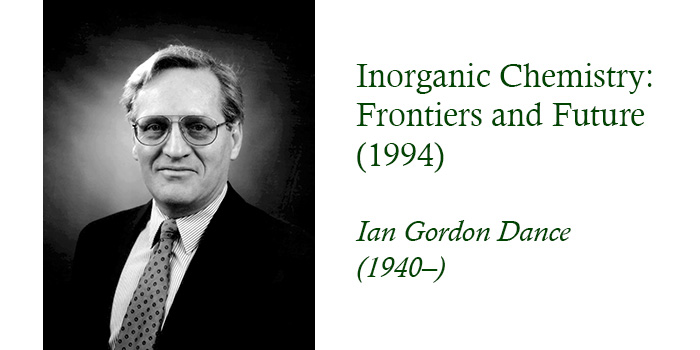29: Inorganic Chemistry: Frontiers and Future (1994)
Abstract
Liversidge Research Lecture delivered before the Royal Society of New south Wales, 9th August, 1994. Reproduced by permission of the Royal Society of New South Wales from J. Proc. Roy. Soc. N.S.W., 1995, 128, 131-140.
"Inorganic chemistry - the chemistry of all elements - has turned up some real surprises in the last few years. Even elemental carbon is undergoing a revolution, literally. Molecules which are simply binary combinations of the elements, such as MxSy and MxCy, have been discovered. These are molecular fragments of compounds otherwise known only as non-molecular solids, and are totally unexpected and unpredictable: their structures are being explored by computational methods. The multiple "non-bonded" interactions between inorganic molecules in crystals are being recognised and understood, and can be deployed in crystal engineering. Highly evolved molecular biology reveals tantalising chemical possibilities beyond current laboratory capabilities, such as the mild reduction of the most recalcitrant molecule in chemistry, N2, by the enzyme nitrogenase. Insight into the mechanism of this enzyme comes from investigations of the clusters MxCy."
References
Bolin, J.T., Campobasso, N., Muchmore, S.W., Mortenson, L.E. and Morgan, T.V., 1993. J. Inorganic Biochemistry, 51, 356.
Chan, M.K., Kim, J. and Rees, D.C, 1993. Science, 260, 792-794.
Dance, I.G., 1992. Geometric and Electronic Structures of [Ti8C12]: Analogies with C60, J. Chemical Society, Chemical Communications, 1779.
Dance, I.G., 1993a. Structural Principles for Copper Carbohedrene Clusters [Cux(C2)y]+, J. Chemical Society, Chemical Communications, 1306-1308.
Dance, I.G., 1993b. Structures and Structural Principles for Copper Carbohedrene Clusters [Cu13C12]+ to [Cu25C24]+, J. American Chemical Society, 115, 11052-3.
Dance, I.G., 1994. Australian Journal of Chemistry, 47, 979-990.
Dance, I.G., 1995. Supramolecular Inorganic Chemistry, in Perspectives in Supramolecular Chemistry, G. Desiraju (Ed.), John Wiley.
Dance, I.G., Dean, P.A.W.D. and Fisher, K.J., 1994. Gas Phase Metal Cyanide Chemistry: Formation, Reactions and Structures of Copper(I) and Silver(I) Cyanide Clusters, Inorganic Chemistry, 33, 6261-6269.
Dance, I.G., Dean, P.A.W.D. and Fisher, K.J., 1995. Self-assembled Helicates of Zinc and Cadmium Cyanides, Angewandte Chemie, International Edition in English, 34, 314-316.
Dance, I.G. and Fisher, K.J. 1994. Metal Chalcogenide Clusters, MxEy: Generation and Structure, in Soft Chemistry Routes to New Materials, J. Rouxel, M. Tournoux and R. Brec (eds), Trans Tech Publications, Switzerland.
Dance, I.G., Garbutt, R.G., Craig, D.C. and Scudder, M.L., 1987. Inorganic Chemistry, 26, 4057-4064.
Dance, I.G., Garbutt, R.G. and Bailey, T.D., 1990. Inorganic Chemistry, 29, 603-8.
Dance, I.G., Garbutt, R.G. and Scudder, M.L., 1990. Inorganic Chemistry, 29, 1571-5.
Dance, I.G. and Scudder, M.L. 1995. The Sextuple Phenyl Embrace, a Ubiquitous Concerted Supramolecular Motif, Ian Dance and Marcia Scudder, J. Chemical Society, Chemical Communications, 1039-1040.
Dhingra, S. and Kanatzidis, M.G., 1993. Inorganic Chemistry, 32, 3300-3305.
El Nakat, J., Fisher, K.J., Dance, I.G. and Willett, G.D., 1993. Inorganic Chemistry, 32, 1931-1940.
Kim, J. and Rees, D.C, 1992. Nature, 360, 553-560.
Lehn, J.-M., 1990. Angewandte Chemie, International Edition in English, 29, 1304-1319.

